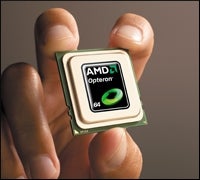 |
SUNNYVALE, Calif. — Advanced Micro Devices said today that it’s moving forward with new Opteron server processor designs that will eventually reach 16 cores by 2011.
In a briefing here at its near-empty California offices — the company has all but moved to Austin, Texas — AMD (NYSE: AMD) executives laid out a revised and extended roadmap for server processors, showing the company remains committed despite the server business being notably down, according to yesterday’s earnings call.
The date for today’s news — April 22 — was not chosen casually. It is the 6th anniversary of the original, single-core Opteron processor. So in honor of its birthday, AMD introduced a few more parts.
CEO Dirk Meyer said on the earnings call with analysts yesterday that the company had moved up the release date of “Istanbul,” its six-core processor. It ships to partners next month and they begin shipping new servers in June. Istanbul is socket-compatible with older servers, so existing Opteron servers can pop out the old chip and drop in the new one, provided they perform a BIOS
AMD is also now testing and qualifying its 12-core “Magny-Cours” processor, which is on track for release in Q1 2010, according to Pat Patla, vice president and general manager of server products.
Magny-Cours will feature a major change to the architecture, so it will not be socket-compatible with older systems. Coming in 2011 will be the Bulldozer generation of processors, the first being codenamed “Interlagos” and due to ship with 12 to 16 processor cores. It will be drop-in compatible with Magny-Cours-class motherboards.
This new processor will feature four HyperTransport links instead of three in current chips, will come with a four-channel integrated controller instead of three channels, and updated AMD-V and AMD-P virtualization and power management. The Interlagos generation will also feature Direct Connect Architecture 2.0.
With this, Patla is promising a near-linear scaling in processors, something that doesn’t usually happen when cores are doubled, which typically results in a 50 percent improvement in performance, not 100 percent. But AMD says it will get there through balancing system elements and not focusing on just the CPU, but on memory and the I/O subsystem as well.
This will result in two new families, the Opteron 6000 and 4000 lines. The 6000 will use the G34 chipset and is aimed at the high-performance market. It will support up to four channels of DDR3 memory with 12 memory DIMMs per socket.
The Opteron 4000 will use the C32 chipset, supports two channels of DDR3 memory and is aimed at the one or two-socket mainstream server market.
The 6000 line will be the 12-core, 45nm Magny-Cours line, followed by the 12 to 16-core, 32nm Interlagos line. AMD will make the jump to High-K Metal Gate for 32nm, a technology that Intel (NASDAQ: INTC) adopted at 45nm.
The 4000 line will consist of the four to six-core “Lisbon” processor in 2010, which will use 45nm design, followed by “Valencia,” a six to eight-core 32nm design in 2011.
One thing AMD is not interested in is multithreading. Sun’s Niagara CMT processors handle eight threads per core, while Intel’s new Nehalem-generation Xeon 5500 does two threads per core.
Multithreading is nowhere to be seen on AMD’s roadmap, nor is it interested. It’s going for regular cores, not fudging it with threads. “We think we’re pretty well covered in the 48 to 64 thread environment for the next few years,” Patla said. “We’ll see where we are come 2012.”
April 22 is also Earth Day, and so fittingly, AMD introduced a new ultra-low power Opteron, the 40-watt Opteron EE processor. The new CPU has a quad-core design and runs at 2.1GHz and 2.3GHz. The processors are available now from AMD resellers.


